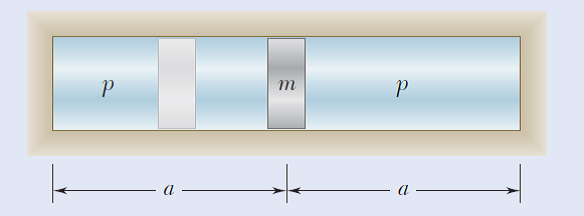
Elements Of Electromagnetics
7th Edition
ISBN: 9780190698614
Author: Sadiku, Matthew N. O.
Publisher: Oxford University Press
expand_more
expand_more
format_list_bulleted
Concept explainers
Question
A piston of mass m and cross-sectional area A is in equilibrium under the pressure p at the center of a cylinder closed at both ends. Assuming that the piston is moved to the left a distance a 2 and released, and knowing that the pressure on each side of the piston varies inversely with the volume, determine the velocity of the piston as it again reaches the center of the cylinder. Neglect friction between the piston and the cylinder and express your answer in terms of m, a, P and A.

Transcribed Image Text:т
Expert Solution
This question has been solved!
Explore an expertly crafted, step-by-step solution for a thorough understanding of key concepts.
Step by stepSolved in 5 steps with 1 images

Knowledge Booster
Learn more about
Need a deep-dive on the concept behind this application? Look no further. Learn more about this topic, mechanical-engineering and related others by exploring similar questions and additional content below.Similar questions
- Dyanmics Engineering review Part B Determine the normal force of the rod on the collar at B. Express your answer to three significant figures and include the appropriate units. N = Part C Determine the rate of increase in collar's speed at B. Express your answer to three significant figures and include the appropriate units. a =arrow_forwardA 3.08-g bullet embeds itself in a 1.7-kg block, which is attached to a spring of force constant 827-N/m. If the maximum compression of the spring is 4.45-cm, find the time of the bullet-block system to come to rest. Provide your final answer in milli seconds.arrow_forwardQ5) The 50-kg crate shown rests on a rough horizontal surface for which the coefficient of kinetic friction is #x=0.3. An electrically powered winch is utilized to accelerate the crate at a constant rate until it attains a speed of v-Sm's within a distance of s=20m. If the motor and the winch have an efficiency of n-0.70, determine the power that must be supplied to the motor when s= 20 m. 20 m 50 kg Darrow_forward
- 2. (25) The small 2-kg block A slides down the curved path and passes the lowest point B with a speed of 4 m/s. If the radius of curvature of the path at B is 1.5 m, and the coefficient of friction between the block and path is 0.3, determine (a) the normal force exerted on the block by the path at B, and (b) the rate of change of speed at this point. Barrow_forwardA bullet (W₁ = 3.5 oz) with a is fired horizontally with a velocity v₁ = 1675 ft/sec into the block (W₂ = 5.7 lb) of soft wood initially at rest on the horizontal surface. The bullet emerges from the block with the velocity v₂ = 1280 ft/sec, and the block is observed to slide a distance of d = 7.3 ft before coming to rest. Determine the coefficient of kinetic friction μk between the block and the supporting surface. Answer: Uk= i W₁ W₂arrow_forwardA stream of water flowing at a rate of 1.2 m3/min and moving with a speed of 30 m/s at both A and B is deflected by a vane welded to a hinged plate. Knowing that the combined mass of the vane and plate is 20 kg with the mass center at point G , determine (a) the angle 0, (b) the reaction at C.arrow_forward
- N= 11.03N F= 25 Narrow_forwardA double radius pulley is attached to a wall by an axle of negligible friction and is initially at rest. Two vertical forces,both with magnitude F1P = F2P =19 N, are applied at the radii R1 =0.4 m and R2 =1 m as shown.Determine the kinetic energy of the pulley after it has undergone one full rotation.arrow_forward
arrow_back_ios
arrow_forward_ios
Recommended textbooks for you
 Elements Of ElectromagneticsMechanical EngineeringISBN:9780190698614Author:Sadiku, Matthew N. O.Publisher:Oxford University Press
Elements Of ElectromagneticsMechanical EngineeringISBN:9780190698614Author:Sadiku, Matthew N. O.Publisher:Oxford University Press Mechanics of Materials (10th Edition)Mechanical EngineeringISBN:9780134319650Author:Russell C. HibbelerPublisher:PEARSON
Mechanics of Materials (10th Edition)Mechanical EngineeringISBN:9780134319650Author:Russell C. HibbelerPublisher:PEARSON Thermodynamics: An Engineering ApproachMechanical EngineeringISBN:9781259822674Author:Yunus A. Cengel Dr., Michael A. BolesPublisher:McGraw-Hill Education
Thermodynamics: An Engineering ApproachMechanical EngineeringISBN:9781259822674Author:Yunus A. Cengel Dr., Michael A. BolesPublisher:McGraw-Hill Education Control Systems EngineeringMechanical EngineeringISBN:9781118170519Author:Norman S. NisePublisher:WILEY
Control Systems EngineeringMechanical EngineeringISBN:9781118170519Author:Norman S. NisePublisher:WILEY Mechanics of Materials (MindTap Course List)Mechanical EngineeringISBN:9781337093347Author:Barry J. Goodno, James M. GerePublisher:Cengage Learning
Mechanics of Materials (MindTap Course List)Mechanical EngineeringISBN:9781337093347Author:Barry J. Goodno, James M. GerePublisher:Cengage Learning Engineering Mechanics: StaticsMechanical EngineeringISBN:9781118807330Author:James L. Meriam, L. G. Kraige, J. N. BoltonPublisher:WILEY
Engineering Mechanics: StaticsMechanical EngineeringISBN:9781118807330Author:James L. Meriam, L. G. Kraige, J. N. BoltonPublisher:WILEY

Elements Of Electromagnetics
Mechanical Engineering
ISBN:9780190698614
Author:Sadiku, Matthew N. O.
Publisher:Oxford University Press

Mechanics of Materials (10th Edition)
Mechanical Engineering
ISBN:9780134319650
Author:Russell C. Hibbeler
Publisher:PEARSON

Thermodynamics: An Engineering Approach
Mechanical Engineering
ISBN:9781259822674
Author:Yunus A. Cengel Dr., Michael A. Boles
Publisher:McGraw-Hill Education

Control Systems Engineering
Mechanical Engineering
ISBN:9781118170519
Author:Norman S. Nise
Publisher:WILEY

Mechanics of Materials (MindTap Course List)
Mechanical Engineering
ISBN:9781337093347
Author:Barry J. Goodno, James M. Gere
Publisher:Cengage Learning

Engineering Mechanics: Statics
Mechanical Engineering
ISBN:9781118807330
Author:James L. Meriam, L. G. Kraige, J. N. Bolton
Publisher:WILEY